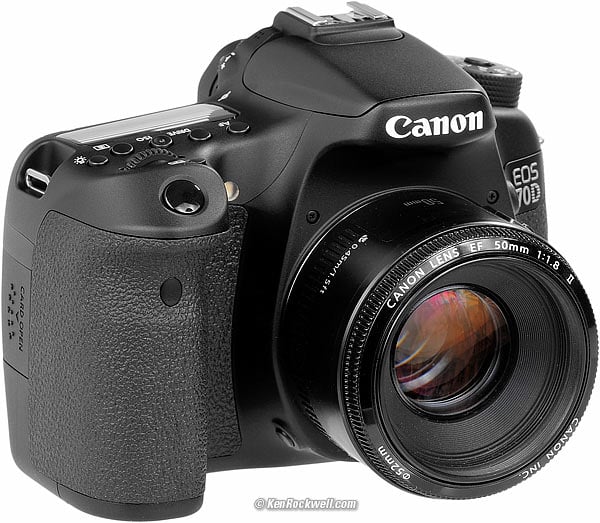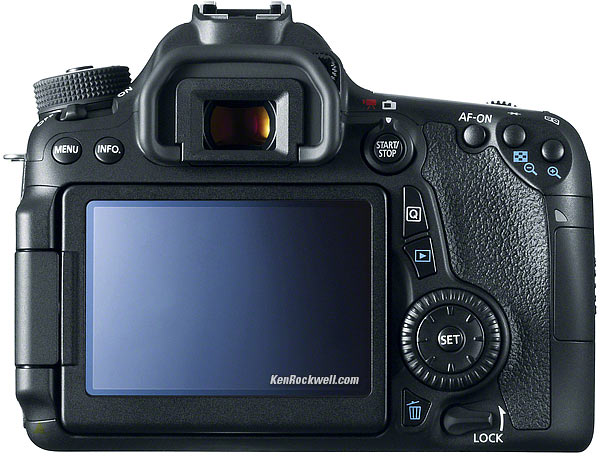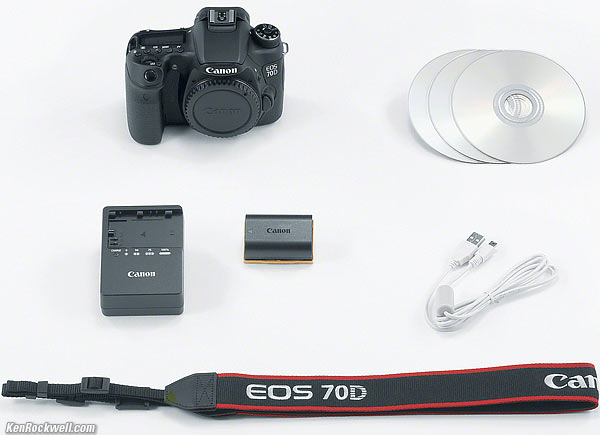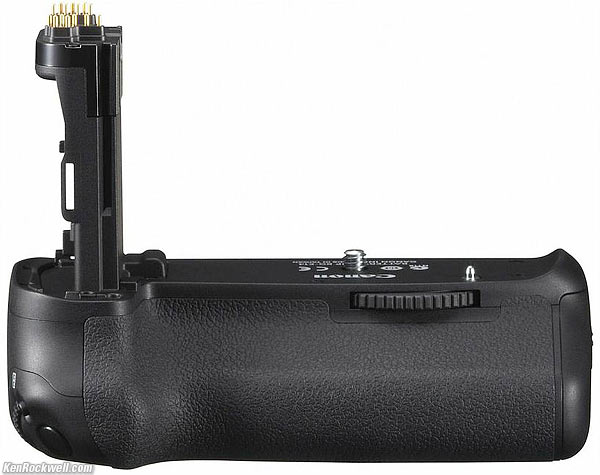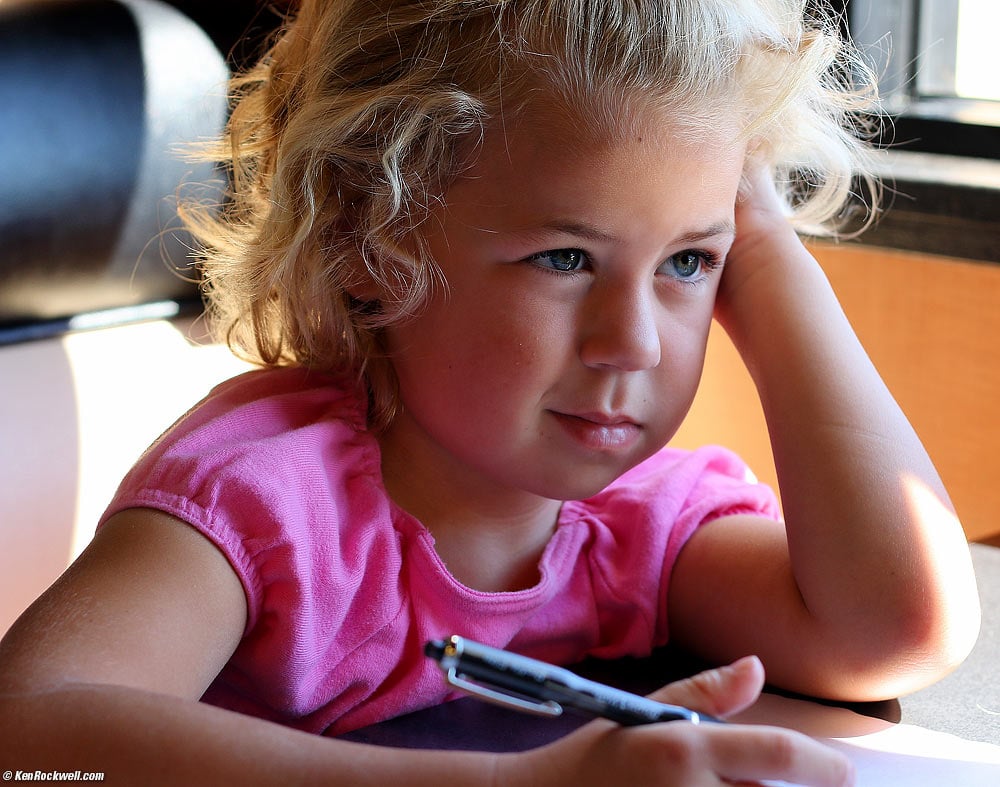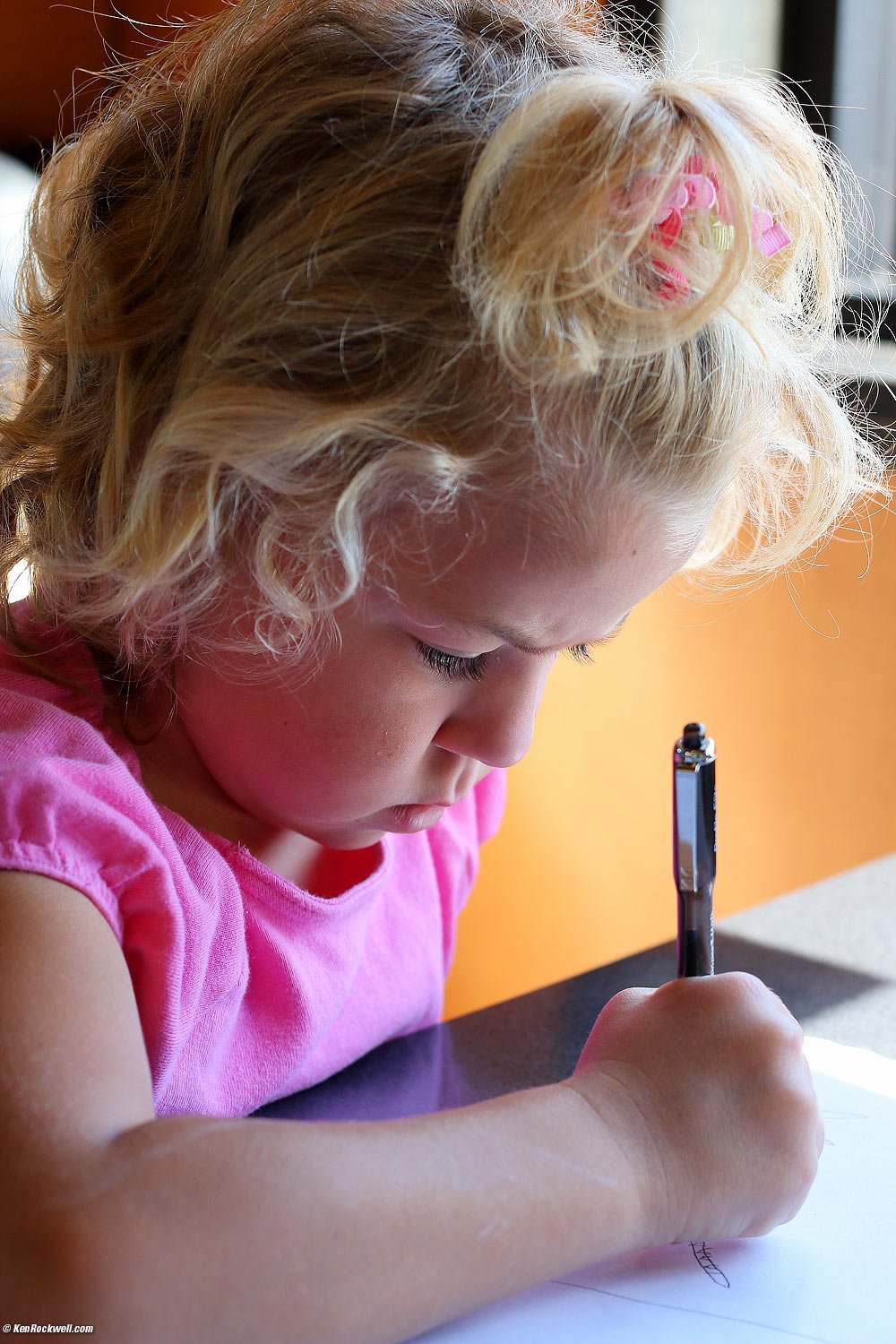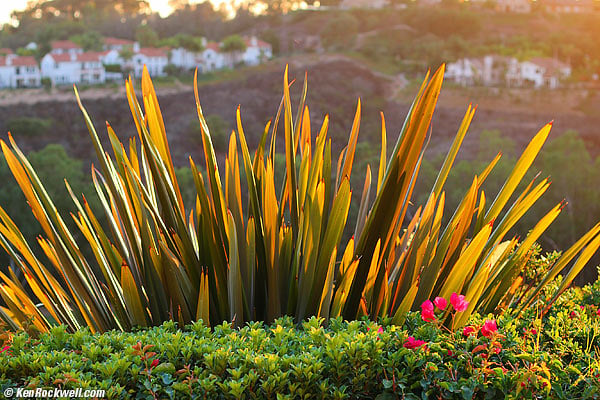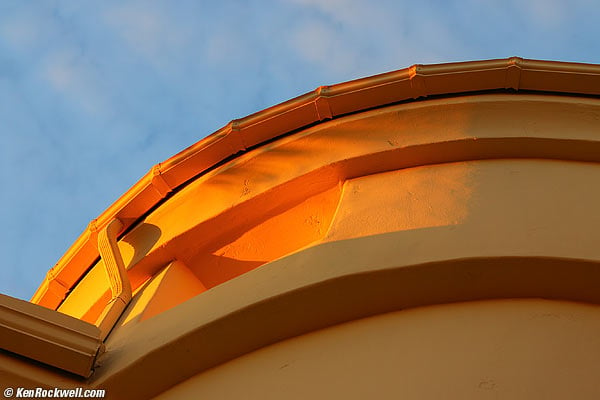Home Donate New Search Gallery Reviews How-To Books Links Workshops About Contact
Canon 70D
20MP, 7 FPS, Wi-Fi, Touch LCD
© KenRockwell.com. All rights reserved.
Intro Specs Performance Compared Recommendations More Press
Canon 70D (1.6x sensor (nearly APS-C)), 26.7 oz./756g with battery and card, about $949) and Canon 50mm f/1.8 II. enlarge. It comes as body-only ($949), kit with 18-55mm STM ($1,049) or kit with 18-135mm STM ($1,249).
I got mine at Adorama; I'd also get it at at Amazon or at B&H. This ad- free website's biggest source of support is when you use those or any of these links when you get anything, regardless of the country in which you live — but I receive nothing for my efforts if you buy elsewhere. Use any of these links for the best prices and service whenever you get anything. Thanks for helping me help you! Ken.
June 2015 Canon Reviews Canon Lenses All Reviews
DEAL: Canon 70D, PIXMA PRO-100 printer, Canon photo paper and Corel software:
$849.99 after $250 Mail in Rebate ($1,099.99 checkout price - $250 Rebate = $849.99) — with free US shipping!
The deal behind this deal is you probably don't want the printer, so you eBay it and pocket the cash, making this even more of a deal.
Sample live autofocus video clip (640x480, 52 MB MOV file). It looks harsh because I had the saturation cranked to +1, which is too much for people video. The aperture varied, looking to be about f/2.8-f/8 most of the time, shot with the Canon 50mm f/1.8. If I had shot this with the 18-135mm STM or another silent-focus STM lens, the audio wouldn't have the chattering from the lens focusing and might focus faster, too.

Top, Canon 70D and 18-135mm STM.
Back, Canon 70D. enlarge.
Introduction top
Intro Specs Performance Compared Recommendations More Press
|
Adorama pays top dollar for your used gear. I use these stores. I can't vouch for ads below. |
The Canon 70D is Canon's least-expensive full-performance DSLR. I can't think of anything significant missing on the 70D for a normal person not made of money. The 70D is a fantastic camera at any price. If you think you want one, just get it. The 70D shoots fast and it's always right on-target. Everything about the 70D just goes!
When I pick up the 70D, it feels and shoots just like my $3,500 5D Mark III, and the photos look the same for all practical purposes — and the 70D is much smaller and lighter, and only a fraction of the price.
The only benefits to me of my older 5D Mark III (it came out in 2012) are that my 5D Mark III has an automatic brightness control for the rear LCD, a second card slot and three "C" camera presets. The 5D Mark III has a larger image sensor than the 70D, which means you have to use much bigger, heavier and more expensive lenses to take the same pictures. Some people prefer to carry bigger lenses, but in 2013, the only real reason to use the "full-frame" 5D Mark III is if you want narrower depth of field and a larger viewfinder. Not only is the 70D smaller and lighter, it adds a built-in flash, sorely lacking on the 5D Mark III.
New
The newest thing about the Canon 70D is what Canon calls "Dual Pixel AF," which gives slightly better and much smoother autofocus for movies. Still photo autofocus is excellent as always.
The 70D has limited Wi-Fi ability to talk to a Canon app in your iPhone. This is fun because you now can get photos from your 70D into your iPhone to email them or whatever, but it's even easier just to shoot with your iPhone in the first place.
New [ T ] button near the shutter lets us toggle among one area, a few areas, or auto selection of the AF area modes.
New dedicated BG-14 grip.
No second card slot.
No automatic brightness control for rear LCD.
Top LCD doesn't show selected image size.
Only one, not two or three preset "C" modes. (I set C1 for landscape and C2 for family photos on other cameras, for instance.)
No GPS, thank goodness.
Extra Features
Flippy LCD touch screen.
In live view, touch the screen to define the autofocus point, and touch it again to pull focus smoothly from one subject to the next while shooting video.
Specifications top
Intro Specs Performance Compared Recommendations More Press
Sensor
20 MP CMOS.
1.6x crop factor (22.5 x 15.0 mm, nearly APS-C).
4.1µm square spacing.
Ultrasonic cleaner.
Canon really does have a sensor with some depth in the sensor wells so that it can detect focus directly from the optical 3D image for live "phase-detection" AF, as opposed to having to analyze the image from the sensor for "contrast" AF. This is what Canon clumsily calls "Dual Pixel."
Image sizes
5,472 x 3,648 native, JPG or raw.
Medium (9 MP): 3,648 x 2,432.
Small 1 (5 MP): 2,736 x 1,824.
Small 2 (2.5 MP): 1,920 x 1,280.
Small 3 (TV; 0.35 MP) 720 x 480.
mRAW: (11 MP) 4,104 x 2,736.
sRAW: (5 MP) 2,736 x 1,824.
Cropped Sizes
4:3, 16:9 and 1:1 crops from the above.
ISO
100 - 6,400 in Auto ISO and most cases.
Manually set as high as ISO 12,800 or 25,600 if you like.
Tends to default to ISO 400 with flash or in Bulb.
Lens Compatibility
All Canon EF and EF-s lenses.
Autofocus
19 cross-type AF points working at f/5.6 or faster.
Center point gives extra precision with lenses as fast as f/2.8.
Rated to work from LV 0 to 18. (center point as dark as LV -0.5.)
ONE SHOT, AI SERVO and AI FOCUS modes.
No AF illuminator (will fire the built-in flash for focus assist, which is unacceptable for use with any animate subject.)
5x or 10x Live View magnification for manual focus.
AF fine-tuning.
Finder
98% coverage.
53% magnification with standard for APS-C 28mm lens (95% with 50mm telephoto).
22mm eyepoint.
-3 ~ +1 Diopters.
Fixed focusing screen.
Grid and level overlays, if you choose to activate either.
Live View
Yes.
Light Meter
LV 1-20.
Evaluative, center-weighted, wide-spot and narrow spot.
63-zone, two colors only (still can't see full RGB color as Nikons have metered since the 1990s).
Flash
PC (Prontor-Compur) terminal and dedicated E-TTL II hot shoe.
Built-in flash
Guide Number 12 meters (39 feet) at ISO 100.
Covers as wide as a 17mm lens on the 70D (28mm equivalent felid-of-view on full-frame).
Flash Sync Speed (maximum shutter speed with flash)
1/250.
Shutter
Vertical focal-plane.
30 seconds to 1/8,000 second.
Self Timer
2 or 10 seconds.
Advance Modes
Single.
Continuous fast (7 FPS) or slow (3 FPS). 7 FPS only in ideal conditions, will be slower in actual use.
Silent continuous (3 FPS) or single-shot shooting.
Remote control
Burst Depth
About 50 shots in JPG, 15 shots in raw or 8 in JPG + raw. More with faster cards, less with slower cards.
Video
.MOV files containing MPEG-4 AVC / H.264 video and linear PCM audio.
Meta data is embedded in the file (no need for the old THM files).
IPB or all-I compression.
Frame Rates
1,920 x 1,080 at 23.976p, 25p or 29.97p. (235 MB/min. with IPB compression, 685 MB/min. with all-I compression.)
1,280 x 720 at 50i or 59.94i. (205 MB/min. with IPB compression or 610 MB/min. with all-I compression.)
640 x 480 at 25p or 29.97p. (78 MB/min. with IPB compression.)
Maximum Shot Length
A half hour (29:59), or less if your card is too small.
Audio
Built-in stereo microphone.
Audio recorded only with video.
LCD
3" touch screen.
Swivels all around.
1,040,000 dots
Data Storage
One SD card.
Data Communication
USB.
HDMI type C.
Analog AV (NTSC or PAL).
GPS interface for GP-E2 receiver.
Wi-Fi, only for talking to Canon's own apps.
Power
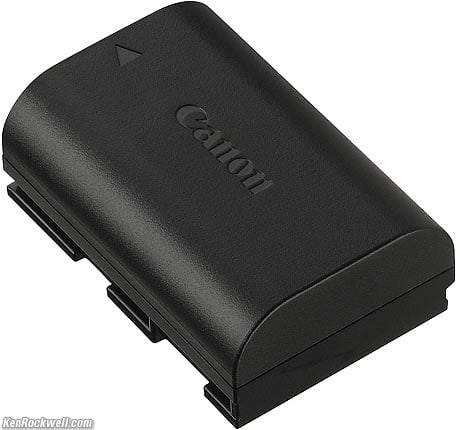
LP-B6 Battery.
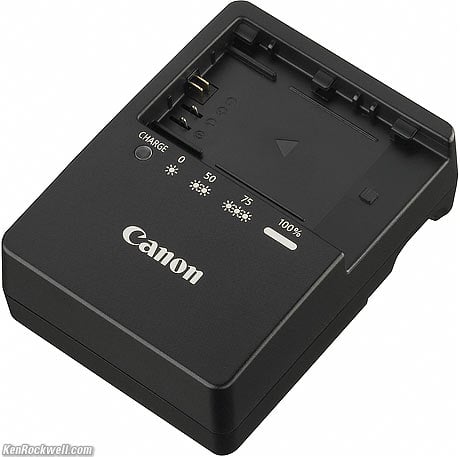
LC-E6 Charger.
LP-E6 7.2V 1.8 Ah Li-Ion rechargeable battery. (same as 5D Mark II, 5D Mark III, 7D etc.)
LC-E6 universal voltage charger included.
Optional AC Adapter Kit ACK-E6.
With BG-14 grip: two LP-E6 or six AA cells.
Four-segment ("six level") battery charge indicator on top LCD and in finder.
Battery charge reads to nearest percent in the menu system, and counts shots made on current charge.
Built-in rechargeable battery for 3-month clock backup; takes 8 hours to charge.
Rated Shots
920 shots with 50% flash, or
210 shots using Live View, or
80 minutes of movie time.
Environmental
0 ~ 40ºC (32~104ºF).
Not more than 85% RH.
Size
5.5 x 4.1 x 3.1 inches.
139.0 x 104.3 x 78.5 millimeters.
Weight
26.685 oz. (756.5g) actual measured with battery and card.
Rated 26.7 oz. (755g) with battery and card.
Rated 23.8 oz. (675g) stripped naked.
Quality
Made in Japan.
Included
(lens if part of a kit.)
EOS 70D camera.
Eyecup Eb.
Battery Pack LP-E6.
Battery Charger LC-E6.
Wide Strap EW-EOS 70D.
USB Interface Cable IFC-130U.
EOS Digital Solution Disk & Software Instruction Manual CD.
Camera Instruction Manual.
Some of what's included with the Canon 70D. enlarge.
Optional Accessories
BG-14 grip for Canon 70D. Takes 2 LP-E6 or six AA cells.
BG-14 grip ($200).
Announced
02 July 2013 at 12:02 AM, NYC time.
Promised for
September 2013.
Shipping since
Late August 2013.
Price, USA
June 2015
$949, body-only.
$1,049, kit with 18-55mm STM.
$1,249, kit with 18-135mm STM.
DEAL: Canon 70D, PIXMA PRO-100 printer, Canon photo paper and Corel software:
$849.99 after $250 Mail in Rebate ($1,099.99 checkout price - $250 Rebate = $849.99) — with free US shipping!
The deal behind this deal is you probably don't want the printer, so you eBay it and pocket the cash, making this even more of a deal.
July 2013
$1,199, body-only.
$1,349, kit with 18-55mm STM.
$1,549, kit with 18-135mm STM.
Performance top
Intro Specs Performance Compared Recommendations More Press
Finder
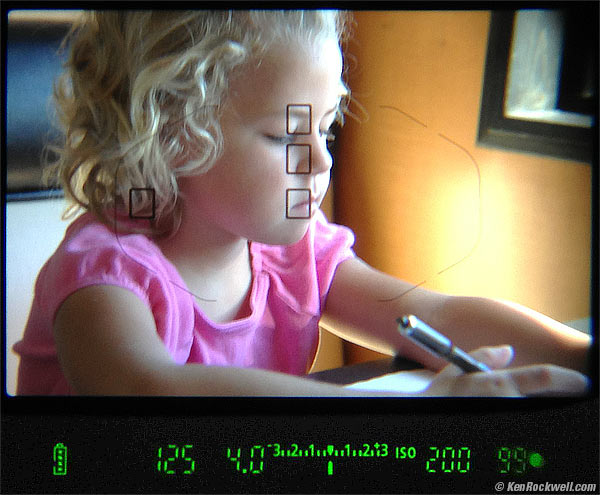
Actual view through finder, auto AF area select mode. (taken with Rockwell centroptic data camera).
The viewfinder is bright, sharp, clean and clear. It's a beauty. It looks much better than shown here, although the AF areas really do clutter the image as seen.
The active AF areas are shown as dark LCD squares, which can obscure your view of the subject. In very dark light, they will blip in red. It makes it difficult if you're trying to see the smile to press the shutter. Older cameras like the EOS-3 and EOS-1V are far better because their AF areas light up by themselves in red, never putting black boxes over your subject. Oh well, even the 1D X has these cheaper black LCD indicators today.
The 70D's finder is life-size with a 50mm lens, making it easy to shoot and set the camera with both eyes open. Like most modern cameras it could be clearer if it were designed without a diopter adjustment.
The screen is optimized for lenses of about f/2.5. Faster lenses won't make the finder any brighter and the finder won't show the actual depth of field at larger apertures than f/2.5.
Still Photo (SLR) Autofocus
Regular AF works great, as we expect.
Auto AF-Area Select, chosen by default, works immediately, choosing mostly the closest AF sensors all by itself. It's much faster than the Auto-Select mode of the EOS-1V, for instance.
The active AF areas are marked in the finder with black LCD boxes, which can make it difficult to see our subject's expressions.
There's a new [ T ] button near the shutter which lets us toggle among one area, a few areas, or auto selection of the AF areas.
Video Autofocus
My Canon 70D's video autofocus is the best yet from a DSLR. No, it's nowhere near as fast as it is for SLR still shots, but as video goes, it's the first I've used that does a decent job of tracking reasonable motion.
Here's a sample live autofocus video clip (640x480, 52 MB MOV file), as shot by my six-year-old. It looks harsh because I had the saturation cranked to +1, which is too much for people video, but otherwise I'm astounded at how smooth it looks as shot in whatever light was there. My 6-year-old did it all, and the 70D did an awesome job of identifying our faces, locking-on and focusing. The aperture varied, looking to be about f/2.8-f/8 most of the time, shot with the Canon EF 50mm f/1.8. If I had shot this with the 18-135mm STM or another silent-focus STM lens, the audio wouldn't have the chattering from the lens focusing and might focus faster, too.
The most important thing for live-view shooting, along with smooth AF, is that you can simply tap the live-view LCD to pull focus from one subject to the next if you want. Tap a face and it focuses there, and tap another face (or the object of a conversation) and it focuses there. Once something gets tapped, it does its best to track it in and out, up and down and left and right as it moves around. (In the demo video above, the 70D operated all by itself finding faces and focusing.)
It is state-of-the-art in DSLR video AF today. DSLRs have much larger sensors than camcorders or iPhones, so they have to move much bigger optics inside much bigger lenses much further to change focus. The 70D's video AF does track moving objects, and like all AF systems, it has its limits as to just how close you can get how fast before it loses lock. Camcorders and iPhones have their limits, too.
Shutter
The shutter is relatively sharp-sounding and noisy. The "Silent" mode is quieter, but not by much. At least the Silent mode doesn't slow down the 70D much.
Shutter pull oddly has a slight click as you press it all the way home to fire. Most Japanese cameras, like the 5D Mark III, EOS-1V and Nikons have a smooth pull, while the SL1 and this 70D have a click at the end of their travel. I don't like this click; digital LEICAs do this and I doubt it helps image sharpness at slow speeds.
Ergonomics
Everything responds instantly. Bravo!
There is no exposure mode indication in the finder. If you want to switch from P to Av or C, you've got to count clicks and pray.
The pop-up flash button is easy to find by feel, but oddly is surrounded by a raised guard, so it often ignores me (or my six-year-old) when it's pressed. It should be more responsive.
There's only one preset "C" mode. This is a bummer for me, since I prefer to set C1 on my other Canons for my landscape shots, and C2 for family shots. I preset all sorts of different image sizes, saturations and AF settings for each preset, all of which are recalled, so not having at least a second "C" mode makes it much more difficult for me to snap both my family and landscape shots at the same time without a lot of fiddling.
The self-timer light is a super-annoying bright yellow light.
The touch screen responds as well as an iPhone, but it demands a second (left) hand to operate. I prefer being able to play and zoom and set the camera using only my right hand, which still works pretty well since the usual buttons are still there. The touch screen simply duplicates much of what you can do, so you have the option of using either.
Technical Image Quality
Resolution and High ISOs
Digital cameras have been mature since about 2007. Today, they all look fantastic — if you know what you're doing, and if you don't, well, good luck. Resolution is far more than anyone will ever need for anything, and hyper-ISO performance is more than good enough to photograph anything on Earth hand-held.
Here are some snaps at the lowest 5 megapixel setting in the smallest JPG Normal compression setting, shot with Canon's cheapest lens, and they are sharp enough to see the dirt on each eyelash!
Katie imagines what she's going to draw, 01 September 2013. (cropped from Canon 70D, Canon 50mm f/1.8 II, Program and Auto ISO modes set f/4 at 1/125 at ISO 200, 6 sharpening, +1 saturation, no flash, Athentech Perfectly Clear.) bigger or full-resolution SMALL NORMAL JPG.
Katie draws, 01 September 2013. (Canon 70D, Canon 50mm f/1.8 II, Program and Auto ISO modes set f/4 at 1/125 at ISO 200, 6 sharpening, +1 saturation, no flash, Athentech Perfectly Clear.) bigger or full-resolution SMALL NORMAL JPG.
Crop from above image, shown at 100%. If this is about 6" wide on your screen, the entire image printed at this same magnification would be 18 x 28."
Color Rendition
Spear Plant at Last Light. (Canon 70D, Canon 50mm f/1.8 II, Program and Auto ISO modes set f/3.5 at 1/125 at ISO 200, 6 sharpening, +4 saturation, no flash, Athentech Perfectly Clear.) Full-resolution SMALL NORMAL JPG.
Colors are the same excellent colors I get from all my other Canon DSLRs. No problems here; set to the same Picture Style as another camera, the colors match.
Rain Gutter at Last Light. (Canon 70D, Canon 50mm f/1.8 II, Program and Auto ISO modes set f/4 at 1/125 at ISO 100, 6 sharpening, +4 saturation, no flash.) Camera-original SMALL NORMAL JPG.
Movies
Video looks amazing: smooth, clean, sharp and clear.
Call me crazy, but I prefer that the 70D offers a 640x480 resolution setting lacking on the latest Nikons so I can make much smaller files better suited for online distribution, like this one above, which is already 50MB for a 47 second clip.
The built-in mic is stereo.
AF was covered above: it works better than any other DSLR as of September 2013. It doesn't get lost or hunt, and has an astonishing ability to identify faces and lock-on to them, all by itself at its default settings. It can't focus video or Live View anywhere near as fast as it can focus for regular pictures, and it still can't focus as fast as an iPhone, but for most uses it works extremely well without any user input.
Auto White Balance
Auto White Balance performance is about the same as other DSLRs. It won't be happy under florescent, and under tungsten it often will be orange. In bright tungsten light it will correct completely, although in dimmed tungsten it can get a bit reddish-pink. This is all perfectly normal for DSLRs.
The biggest visible difference between photos from the 70D and other kinds of cameras, like the Fuji X100S and the iPhone 5, is that most SLRs like this don't have auto white balance as good as those other cameras that are always seeing the image from their own sensors before you press the shutter. I don't shoot SLRs in live view.
I've seen that the 70D can make shots in rapid succession with slightly different auto white balances, where they all should be the same. No big deal; the Nikon D4 and Canon 1DX have the same problem while the Fuji X100S and the iPhone 5 don't. Like all other DSLRs, if you need color to match exactly from frame-to-frame in the same lighting, use a fixed white balance setting.
Rear LCD Monitor
As I expected, the rear LCD is beautifully clear, sharp, smooth and accurate.
It has no auto brightness control.
The touch-screen feature works well, and it resists fingerprints and stays clean.
All in all, it's almost as good as an iPhone.
Playback
I have to laugh: the 70D still has the same curse Canon DSLRs have had for over ten years: when you're zoomed-in and scroll around the image, you have to wait a moment for the image to redraw with full resolution. What Canon is doing that takes too long to compute that, ten years later still takes this long to compute, is beyond me.
You may touch the screen or press the (+) button to zoom.
You may touch the screen, or press the buttons or dials to swap around to other images.
As always, the rear dial moves by one picture a click, and the top dial moves by ten images per click by default. The action of the top dial is settable in an menu.
Top LCD
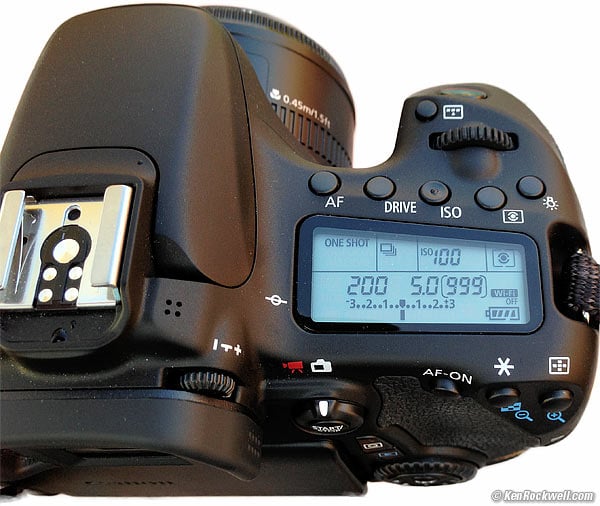
Canon 70D top LCD in use in the field.
The top settings LCD is abbreviated; it doesn't show the resolution setting, for instance, I have to look at the shots remaining and guess — or fire-up the rear LCD.
The orange backlight is excellent. I wish my EOS-1V's LCD was as well lit.
Data
Data is all as we expect from Canon DSLRs.
The card is titled EOS_DIGITAL, not CANON 70D as it ought to, but far better than the retarded "NO NAME" used by dumber brands.
There is still no auto-create folder ability for each day.
Movies are incorrectly named as MVI_0123.MOV, so they sort in different places than the IMG_0123.jpg images you shoot at the same time.
Battery and Power
The LP-E6 is the same battery as used by most of the higher model Canon DSLRs like the 7D, 6D, 5D Mark II and 5D Mark III, so I already have spares and other chargers.
Battery life is pretty much eternal, over 1,000 shots in my normal use per charge. If you shoot a lot of multi-shot sequences you'll probably be able to get over 2,000 shots on a charge, but if you do video, you'll get much less.
The battery gauge in the viewfinder has four segments, and if you look in the menus, reads in percent. The menu system also counts the shots you've made so far on the charge.
The charger is superb. It has a folding plug for easy carrying. The light is brilliant: it blinks yellow while charging, and turns green when full. The number of blinks tells you the approximate charge level as it charges!
Compared top
Intro Specs Performance Compared Recommendations More Press
All of these cameras can make outstanding images under any conditions.
The Canon SL1 stands out as being the world's smallest and lightest DSLR and also only half the price of this 70D, however it is so small that it lacks the extra buttons, knobs and dials that experienced photographers want. It can do all the same things as the others, just that if you're one of the people who actually knows how to use all the functions, it takes a lot more menus and button presses to get there with the SL1 or any of the other Rebels.
This Canon 70D is the best all-around camera for the least amount of money and size and weight. Honestly, it feels and shoots pretty much exactly like my 5D Mark III but weighs and costs a lot less.
The Canon 7D is four years older, more expensive and much heavier, but it has three "C" preset modes and an auto-brightness-controlled LCD. I really love having two or three "C" preset modes, as I set one for family photos and another for nature photos, making it easy to switch between my very different personal settings. For me, I really use the multiple C modes and love that the LCD adjusts for indoors or outdoors automatically, but is it worth it to you for more money and much more weight to carry for a much older camera design?
The Canon 6D is extremely popular because it has a larger image sensor, which honestly doesn't make images that much different except for having less depth of field than the other cameras — and having to use much larger and more expensive lenses to match that larger sensor. Yes, the 6D works a little better at stupid-high ISOs in no light, but those differences are minor and you shouldn't be shooting in starlight handheld anyway. More significant is that the 6D has no built-in-flash, which is a significant disadvantage in real shooting in daylight unless you also want to use a shoe-mounted flash. Daylight fill-flash with the built-in flash of the less expensive cameras is far more important than stupid-high ISOs, so you may as well get the 70D.
The Canon 5D Mark III is the world's best DSLR at any size or price. I use mine daily — but that's because I already own one, and when the 5D Mk III came out, there was no 70D or 6D. Canon introduces the expensive cameras first so we who don't really care about price get them, and then announce less expensive cameras that do the same thing later. Sure, since I use it every day my 5D Mark III is worth it to me, but except for missing the C2 and C3 modes of my 5D Mark III, I'd prefer the light weight and built-in flash of this new 70D. For normal people who just want great photos and want all the controls of the pro cameras, the 70D is the new winner.
Real-World Comparison
Megapixels and ISOs no longer mean anything, In fact, I shouldn't have listed the AF sensor counts, since they don't mean anything useful either. For instance, the 5D Mk III has 61 sensors and the SL1 has only 9, but the sensors of the SL1 actually cover more of the frame than all the sensors of the 5D Mk III, and the SL1's AF system is much more likely to work while the 5D Mk III's is far more likely to be knocked to some cockamamie setting in which the camera will never focus, so I'll call it a draw among AF systems. Since none of the AF systems cover the entire frame, all my pro friends and I usually use only the center sensor anyway and recompose after focusing. Full-Frame AF is still not here.
Here's what really matters:
| Introduced | 3/2013 |
7/2013 |
9/2009 |
9/2012 |
3/2012 |
| Camera image quality | excellent |
excellent |
excellent |
excellent |
excellent |
| Controls and Buttons | minimal |
full |
full |
full |
full |
| Built-in flash | Yes |
Yes |
Yes |
no |
no |
Sensor Size |
|||||
| Automatic in-camera lens corrections (excluding distortion) | Yes |
Yes |
No |
Yes |
Yes |
| Viewfinder Image Size | a little smaller than medium |
medium |
medium |
big |
big |
| AF Points cover | center region only |
center region only |
center region only |
center region only |
center region only |
| LCD* | 3" Touch Fixed |
3" Touch Swivels |
3"
Fixed |
3"
Fixed |
3.2"
Fixed |
| LCD image quality | excellent |
excellent |
excellent |
excellent |
excellent |
| LCD auto-brightness | no |
no |
Yes |
no |
Yes |
| Live View | Yes |
Yes |
Yes |
Yes |
Yes |
| C modes? | none |
C |
C1 C2 C3 |
C1 C2 |
C1 C2 C3 |
| Video | yes |
yes |
yes |
yes |
yes |
| Wi-Fi to iPhone | no |
yes |
no |
yes |
no |
| GPS receiver | no |
no |
no |
yes |
no |
| Card Slots | 1-SD |
1-SD |
1-CF |
1-SD |
1-SD |
| Battery | |||||
| Weight, with battery and card | 14.2 oz. 403g |
26.7 oz. 756g |
32.3 oz. 915g |
26.8 oz. 760g |
33.7 oz. 956g |
| Price, 9/2013 |
* all these LCDs are bright, sharp, clean, clear, crisp, smooth and colorful LCDs. Unlike earlier cameras, these are all excellent today.
Recommendations top
Intro Specs Performance Compared Recommendations More Press
Want one? BUY ONE!
See Compared above for all the plusses and minuses.
The 70D is the least expensive full-performance Canon there is. Paying more for a camera isn't going to get you anything more, unless you really want a larger camera or auto LCD backlight control or all three "C" preset settings as I do — but I shoot every day.
Lenses
I'd get the wonderful 18-135mm STM offered as part of a kit. It's the only lens you'd ever need for almost anything. It's sharp, covers every focal length, and focuses silently for shooting movies.
See Canon Lens Reviews for more.
Flash
I'd use the built-in flash.
I'd only bother with a larger flash if you really need a lot of flash power, or shoot so rapidly that the built-in can't recycle itself fast enough for the next shot.
Personally, I use a used Canon 220EX when I need a bigger flash. It works great and is small.
More Information top
Intro Specs Performance Compared Recommendations More Press
Canon's page on the new AF system
More from Canon about the new AF system
From the Press Release top
Intro Specs Performance Compared Recommendations More Press
Canon’s newly-developed Dual Pixel CMOS AF, a phase-detection autofocus (AF) technology on the camera’s image sensor plane, enables users to shoot video with the new EOS 70D close to the quality of a video shot with a camcorder. Dual Pixel CMOS AF employs a revolutionary CMOS sensor on which all of the effective pixels are able to perform both still imaging and phase-detection AF simultaneously to achieve dramatically improved AF performance over other EOS cameras during Live View shooting and when shooting video.
Wi-Fi
The EOS 70D Digital SLR camera’s built-in wireless transmitter offers users several connectivity options to easily share their images. With the download of the free EOS Remote app from the Apple App Store or the Google Play store, users can connect to both iOS or Android smartphones and tablets to transfer photos and videos wirelessly from their camera to their doo-dad. They can also control aperture, shutter speed, and ISO from their smartphone. The EOS 70D has the ability to connect wirelessly to computers, DLNA devices, Wi-Fi Canon cameras and wireless PictBridge compatible printers, such as the PIXMA MG6320 Wireless Photo All-In-One printer model.
Still Performance
Has a new 20 MP APS-C Canon CMOS sensor and 19-point all cross-type AF system (including a high-precision f/2.8 dual cross-type AF center point).
Has a built-in Electronic Level Function, Manual WB settings and AF Microadjustment.
Enhanced EOS Full HD Movie Mode for Professional Quality Video
With Canon’s new Dual Pixel CMOS AF system and Movie Servo AF, the camera provides continuous phase-detection AF during video recording for quick and accurate focus tracking of moving subjects in the central 80 percent of the imaging area.
While shooting with any of Canon’s Stepping Motor (STM) lenses, such as the new EF-S 18-55mm f/3.5-5.6 IS STM lens, motor noise from the lens is significantly reduced so the camera will only capture the stereo sound of the scene being recorded.
For added flexibility, the EOS 70D Digital SLR camera also features a built-in stereo microphone with manual audio level adjustment and an attenuator function to reduce audio clipping, an accessory jack for external stereo microphones and Video Snapshot mode with editing for expanded video shooting options. When users select the EOS Movie Mode, the EOS 70D offers the ability to shoot in 1080p Full HD video up to 30 fps in either ALL-I or IPB codecs with optional embedded time code, matching the flexibility of other current EOS cameras such as the EOS-1D X, EOS 5D Mark III, and EOS 6D models.
Expanding Creativity
The EOS 70D Digital SLR camera provides advanced amateur photographers and photo hobbyists looking to hone their creative and technical skills with an innovative range of in-camera imaging features such as High Dynamic Range, Multiple Exposure, Handheld Night Scene and HDR Backlight Control modes that allow for expanded creativity. The new camera is also equipped with built-in RAW Image Processing and Image Resizing functions.
When any one of the seven Creative Filters is applied in Live View, users can preview the effect of the filter on the three-inch Vari-Angle Touch Screen monitor without having to shoot the image first. Users can pick from effects such as Art Bold, Fish-eye, Water-painting, Grainy Black and White, Soft Focus, Toy Camera and Miniature and choose the one that best expresses their creative vision before or after the image is captured.
All of these features, when combined with a high-resolution Vari-angle Touch Screen 3.0-inch Clear View LCD monitor II with intuitive touch controls featuring multi-touch operation and Touch AF, make it the ideal camera choice for photographers looking for the best in imaging technology.
The EOS 70D is compatible with the full line of Canon EF and EF-S lenses as well as SD/SDHC/SDXC memory cards, including Ultra High Speed (UHS-1) cards.
Miraculous (claimed) AF System
Dual Pixel CMOS AF, is claimed as a phase-detection AF technology conducted directly on the image sensor plane, employing a CMOS sensor on which all of the effective pixels are able to perform both imaging and phase-detection AF simultaneously claimed to achieve improved AF performance over prior EOS cameras during Live View and video shooting.

Each pixel has two independent photodiodes (elements that transform light into electrical signals) which output signals that can be used for both imaging and the phase-detection AF. With Live View, the technology enables autofocusing similar to shooting through the viewfinder, enabling sharp focus to be obtained across a wide shooting area through phase-detection AF until final focus is achieved. Compared with earlier generations of Canon’s image-plane phase-detection AF, Dual Pixel CMOS AF claims again shorter focusing times, outstanding tracking performance and smoother autofocusing during video shooting. We've all heard that before.
Compared with the new Canon SL1, the 70D is not quite 30 percent faster and also claims better Movie AF tracking for moving subjects.
How Dual Pixel CMOS AF Works

Phase-detection AF
With conventional phase-detection AF, the light that enters through the photographic lens is divided into two images. The difference in the focus point position between the two images is measured on a dedicated AF sensor rather than the image sensor itself, enabling the camera to determine the direction and amount of lens adjustment required to obtain proper focus. Because phase-detection AF enables fast focusing performance compared with contrast-detection AF, the technology is widely employed in digital SLR cameras, mainly for viewfinder shooting.
Dual Pixel CMOS AF employs the same measurement principle as a dedicated AF sensor, except that it is carried out directly with the image sensor. Its large coverage area enables smooth and reliable image-plane phase-detection AF for both still images and video with no reliance on dedicated AF sensors or contrast-detection AF.
Contrast AF
Contrast AF is an autofocus method employed in compact digital cameras and video camcorders, as well as conventional digital SLR cameras for Live View shooting. Because contrast is highest when an image is in proper focus, the camera analyzes the contrast information from the image on the image sensor, adjusting the lens until the maximum contrast value is reached. While contrast AF offers high focusing accuracy, it tends to require more time compared with phase-detection AF because the focusing components of the lens must be driven during AF measurement to find the point of peak contrast.
Hybrid CMOS AF versus Hybrid CMOS AF II
Hybrid CMOS AF in the T5i and the EOS M also claim faster focusing. Combining fast phase-detection AF and high-accuracy contrast AF, Hybrid CMOS AF is faster than contrast AF alone. The SL1 has Hybrid CMOS AF II, which makes use of an imaging sensor that supports AF across a wide area spanning approximately 80 percent of the picture.
Help me help you top
I support my growing family through this website, as crazy as it might seem.
The biggest help is when you use any of these links when you get anything, regardless of the country in which you live. It costs you nothing, and is this site's, and thus my family's, biggest source of support. These places have the best prices and service, which is why I've used them since before this website existed. I recommend them all personally.
If you find this page as helpful as a book you might have had to buy or a workshop you may have had to take, feel free to help me continue helping everyone.
If you've gotten your gear through one of my links or helped otherwise, you're family. It's great people like you who allow me to keep adding to this site full-time. Thanks!
If you haven't helped yet, please do, and consider helping me with a gift of $5.00.
As this page is copyrighted and formally registered, it is unlawful to make copies, especially in the form of printouts for personal use. If you wish to make a printout for personal use, you are granted one-time permission only if you PayPal me $5.00 per printout or part thereof. Thank you!
Thanks for reading!
Mr. & Mrs. Ken Rockwell, Ryan and Katie.
Home Donate New Search Gallery Reviews How-To Books Links Workshops About Contact

